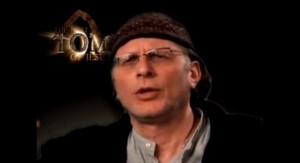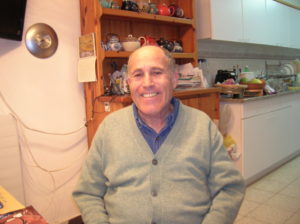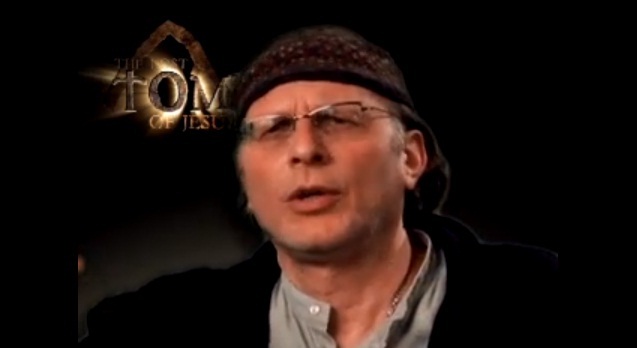Strange Report from Prof. Amos Kloner at the Bar Ilan Archaeological Conference: Cover Up or Incompetence?
 Today, Bar Ilan University, near Tel Aviv, had a one day archaeological conference about various “new finds” in Jerusalem and its surroundings. There were numerous papers, some of them more interesting than others. I went to hear Prof. Amos Kloner’s presentation on the so-called “Patio Tomb” which was the subject of my recent film “The Jesus Discovery/The Resurrection Tomb Mystery” which aired on the Discovery Channel in the US and on Vision TV in Canada. The tomb was also the subject of a book I co-wrote with Prof. James Tabor “The Jesus Discovery” (Simon & Schuster, 2012). In the film and the book, we presented the results of an archaeological investigation into a sealed tomb 60 meters from the alleged tomb of Jesus of Nazareth. Two findings that rocked the archaeological world and made international headlines were the earliest image of the “Sign of Jonah”, associated with the first followers of Jesus, and the first ever inscription on an ossuary (bone box) declaring faith in resurrection.
Today, Bar Ilan University, near Tel Aviv, had a one day archaeological conference about various “new finds” in Jerusalem and its surroundings. There were numerous papers, some of them more interesting than others. I went to hear Prof. Amos Kloner’s presentation on the so-called “Patio Tomb” which was the subject of my recent film “The Jesus Discovery/The Resurrection Tomb Mystery” which aired on the Discovery Channel in the US and on Vision TV in Canada. The tomb was also the subject of a book I co-wrote with Prof. James Tabor “The Jesus Discovery” (Simon & Schuster, 2012). In the film and the book, we presented the results of an archaeological investigation into a sealed tomb 60 meters from the alleged tomb of Jesus of Nazareth. Two findings that rocked the archaeological world and made international headlines were the earliest image of the “Sign of Jonah”, associated with the first followers of Jesus, and the first ever inscription on an ossuary (bone box) declaring faith in resurrection.
As we expected, many challenged the findings. The “Jonah” image was not a “Jonah” image they said, and the fish is not a fish. Rather, it’s a plain old amphora/vase. As for the inscription, most scholars have stayed on the sidelines, but a couple challenged the resurrection interpretation. All this is fine and good; it’s called academic debate. But it was pretty embarrassing for Prof. Kloner. After all, he was responsible for Jerusalem archaeology in 1981 when the tomb was found. He was the first archaeologist to enter the tomb after builders penetrated it through its ceiling. According to the building manager, Kloner emptied the contents of a bone box belonging to a child in an attempt to remove it. This precipitated a near riot by local Jewish seminary students. Kloner ran out of the tomb with the baby ossuary under his arms. Thereafter, the haredim (orthodox Jewish activists) blocked access to the tomb. Eventually, the tomb was resealed and no one saw its contents until we designed a robotic arm that penetrated into the tomb, and shot video while not upsetting Jewish orthodox sensibilities.
 Since 1981, Kloner did not write a single academic article on the subject. Not one! More than this, he’s kept secret files at home, not sharing drawings and photographs with the Israel Antiquities Authority (IAA) for which he was working. After the film and book came out, he acted as if this was all old news pointing to a couple of paragraphs written about the incident in a now defunct Israeli newspaper called “Davar” as proof that this discovery had already been published. One of his “revelations” today was to project another 1981 clipping from a local Jerusalem newspaper showing the haredim blocking access to the tomb.
Since 1981, Kloner did not write a single academic article on the subject. Not one! More than this, he’s kept secret files at home, not sharing drawings and photographs with the Israel Antiquities Authority (IAA) for which he was working. After the film and book came out, he acted as if this was all old news pointing to a couple of paragraphs written about the incident in a now defunct Israeli newspaper called “Davar” as proof that this discovery had already been published. One of his “revelations” today was to project another 1981 clipping from a local Jerusalem newspaper showing the haredim blocking access to the tomb.
I came to the lecture wondering why Kloner was allowed to speak about a failed excavation he was involved in 33 years ago when the topic was supposed to be “new findings”. But Kloner had promised new disclosures. And, indeed, there were some.
He started the presentation in front of a packed audience of some 300 people by reviewing a front page article in the Israeli daily “Ha’aretz” which featured our finding of the “Sign of Jonah” on an ossuary in the Patio tomb. Thereafter, his entire talk was aimed at stating that only Prof. Tabor and I think that the fish is a fish and that the inscription is noteworthy. According to Kloner, all academics unanimously disparage our findings. More than this, he acted as if this was all old news and the two Hebrew articles covering the stand off with the haredim was equivalent to scientific publications. He also mentioned a couple of lines that he dedicated to this find in a book he published with Boaz Zissu on the Jerusalem necropolis.
Then came the “revelations”. These were two drawings that he made on location in 1981 of the two ossuaries in question. One depicts the fish and the other depicts the inscription. He presented these as a way of stating that what we had found was not significant. He talked so long that by the end the moderator refused to take any questions. I stood up and raised my hand but Kloner would not recognize me. Someone from the audience said I should shout out my question, which I did. Why, I asked, had Kloner been sitting on these drawings for 33 years? Why has he treated these documents which belong in the IAA files as his own personal possessions? As of this writing, there is an active IAA sanctioned dig of the two Talpiot tombs. The license is held by UNC Charlotte and the archaeologist in charge is Prof. Rami Arav from the University of Nebraska. Why hadn’t Kloner shared his drawings with Prof. Arav? Is this the way science is conducted? Is it proper for an archaeologist to hide data in a drawer at home? In any respect, it’s Prof. Kloner’s drawings that are old news now. We have published and broadcast much better photographs (taken by our robotic arm) of what he has hidden for 33 years.
But this leads me to another question; what exactly remains in Prof. Kloner’s secret drawer? For example, he showed many photographs of the ossuaries before they were pulled out of their niches. But he admitted in front of the whole audience that all those ossuaries were pulled out into the central area of the tomb. Where are those photographs? They can teach us a lot.
He showed us drawings of the headline making ossuaries but no photographs. Close ups of the inscription and the illustration would really help. Where are those photographs and why isn’t he showing them to anyone? Furthermore, next to the fish image there is another image of some kind of temple-like structure. Kloner says that he thought it was a temple and he now believes it’s a tomb. In any event, we were not able to access that part of the ossuary with our snake camera. So, in our composite pictures, the center of the “temple” was left blank. Strangely, it’s blank in Kloner’s drawing as well. He had full access to the façade of the ossuary. Why is the center of the temple missing? Is it really blank in the original? Or has Kloner changed the drawing so as to continue to keep one of the images secret? I simply have no explanation for Kloner’s behavior.
Let’s take him at his word; he says that he believes that the fish image is really an “amphora”. If so, for all these years, why didn’t he publish the word “amphora” anywhere? Why aren’t the pictures in the IAA files? Why did he take them home with him? Why did he keep quiet about it for over 30 years? He says the inscription doesn’t amount to much. If so, why didn’t he publish it anyway? How many statements of faith has he found on ossuaries? The story just gets stranger and stranger.
Prof. Kloner, I appeal to you directly: we are continuing to investigate the Talpiot tomb area. Recently, a team led by Prof. Richard Freund of Hartford University and Dr. Paul Bauman from WorleyParsons did tomography for us in the area. I think we located a cistern that the late Joseph Gat reported in 1981. Next year we will probably return to the Patio tomb and try to identify the temple structure completely. Are you going to wait until we publish our results and then give a talk at Bar Ilan University saying you had the information all along, but that you had it hidden in your drawer? Are you going to wait to see what we find and then “reveal” more lost drawings to the world, while continuing to keep secret those inscriptions and images that we have not yet found? What exactly is the purpose of this cynical game? I would have liked to hear your answer.
In conclusion, the fact is that there is an academic dispute going on, but it’s not as one sided as Prof. Kloner would like us to believe. It’s not just me and Prof. James Tabor who believe that Kloner’s “amphora” is really a fish. Prof. James Charlesworth says it’s a fish. Dr. Yuval Baruch, regional archeologist for the IAA, says it’s a fish. And the person who is the world’s leading expert in 1st century Jewish art, Prof. Rachel Hachlili, says it’s a fish. On the matter of Jonah, an inscription with the name “Jonah” was discovered by Prof. James Charlesworth in the head of Kloner’s “amphora”. It seems that it’s an amphora called “Jonah”. And it’s not just Prof. James Charlesworth who sees an inscription there. Prof. Ada Yardeni agrees with Charlesworth’s reading of the first and last letters, but not the middle two. And Prof. Haggai Misgav also sees an inscription there, although he reads a different name. Most importantly, one of Israel’s leading epigraphers, Robert Deutsch, says he has no doubt that the name “Jonah” appears in the head of the fish! In any event, it seems where you see no inscription and report on no inscription, four leading scholars see an inscription and have offered different interpretations.
Finally, on the resurrection inscription, although there is still debate on what it says, at a meeting of experts in Washington DC, Prof. Charlesworth, Prof. Tabor, and Prof. Chris Rollston all agreed that it was “very important”. These findings that you so nonchalantly dismissed today, while continuing to hoard vital information in your house, was the subject of a one month debate on the website of the American Schools of Oriental Research (ASOR). So the findings couldn’t be that unimportant. In any event, you are free to enter the fray and engage in proper academic debate. What you are not free to do is to distort the facts that you don’t like, and hide the facts that we have not yet discovered.
It’s time to come clean Prof. Kloner.

